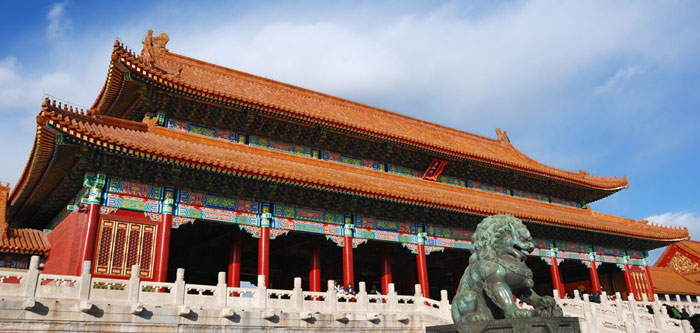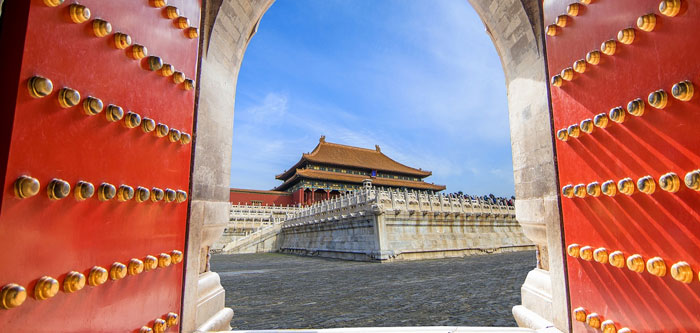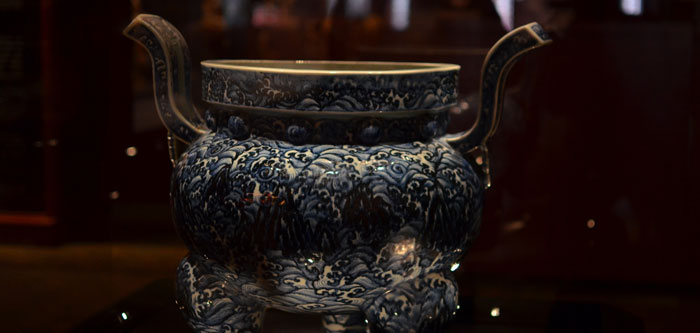The Forbidden City - An Incomparable Chinese Imperial Palace
The Forbidden City is a silent witness of Beijing's history, having been built in the 15th century and used as the Chinese imperial palace until the end of the Qing Dynasty. It is well-known as China's largest and best-preserved example of wooden architecture, and it features more than 9,000 rooms and 70 palaces. It is luxurious, well decorated, mysterious, and solemn. Because an emperor's power was divine and inviolable, the Forbidden City was only for royal families — other people were forbidden to enter without permission. Now that hundreds of years have passed by, the Forbidden City is more like a low-key but solemn elderly person who wants to tell you about all the interesting stories that happened there.

Highlights of the Forbidden City
- Enjoy the largest and best-preserved imperial palace in the world, and try to experience the luxurious Chinese royal lifestyle.
- Admire the numerous precious antiques, and learn about the traditional Chinese history and culture of the ancient dynasties.
- Explore 9,999 rooms and 70 palaces, uncovering the differences between them.
- Find the reasons for its UNESCO World Heritage Site listing and why it attracts visitors from all over the world every day.
Essentials
- Chinese: 故宫 (gùgōng); 紫禁城 (zĭjìnchéng)
- Location: 4 Jingshanqian Street, Dongcheng District, Beijing
- History: over 500 years
- Area: 150,000 square meters
- Honor: one of the UNESCO World Heritage sites; the largest and best-preserved imperial palace in the world; national 5A-level tourism spot
- Tickets: November 1st to March 31st, 40 yuan; April 1st to October 31st, 60 yuan
Architectural Features of the Forbidden City
According to the Feudal Patriarchal Ritual System
The Forbidden City was designed according to the traditional Chinese feudal patriarchal ritual system, and it referred to a classic book in ancient China — 'Zhōulĭkăogōngjì'. Based on this supreme book, the Forbidden City's layout was arranged in a particular way. The left part of it was an ancestral temple; the right of it was the Altar to the Gods of Land and Grain; the front of it was the courtiers' workplace; the back of it was a market. 
Lined Along a North-South Axis
The Forbidden City was lined along a north-south axis, and the three main halls, three main harem palaces, and the Imperial Garden were spread along the axis. This center axis is not only through the Forbidden City, but is also through the entire city from the Gate of Everlasting Stability to the Drum Tower.
The Forbidden City is Divided into Two Parts
The Forbidden City can be divided into two sections: to the south of the Gate of Heavenly Purity is the Outer Court where the emperor exercised supreme power; to the north of it is the Inner Court where the emperor's harem of concubines lived. The Outer Court contains three main palaces: the Hall of Supreme Harmony, the Hall of Central Harmony, and the Hall of Preserving Harmony. Among these palaces, the Hall of Supreme Harmony is the largest and tallest one being 60.1 meters wide, 33.33 meters deep, and 35.05 meters high. The Palace of Heavenly Purity, the Hall of Union, and the Palace of Earthly Tranquility are at the center of the Inner Court. Unlike the first section of the imperial palace, the Inner Court is less spectacular and every palace has its own architectural style.
Top Classic Attractions of the Forbidden City
Hall of Supreme Harmony — the Emperor Frequently Held Grand Ceremonies There
The Hall of Supreme Harmony is also called "jīnluándiàn" in Chinese, and was built in 1420 for the emperor to hold grand ceremonies. These included an emperor ascending to the throne, the emperor's wedding, crowning an empress, and New Year's Day celebrations. This luxurious palace is the largest palace in the Forbidden City at 2,377 square meters. In total, 24 emperors held ceremonies there.
Hall of Mental Cultivation — the Emperor's Living Room
The Hall of Mental Cultivation is a massive "工"-shaped architectural structure located in the west section of the Inner Court. It was used for emperors to read over and give remarks on memorials to the throne, hold confidential talks, and to take a rest. There are three well-known rooms: Emperor Yong Zheng's "Qinzhèngqīnxián" Room, Emperor Qian Long's "Sānxī" Room, and the "Dōngnuăn" Room. You can explore the mysterious Chinese emperors' lifestyle by visiting these typical rooms.
Golden Water Bridge — the Most Beautiful Bridge in the Forbidden City
The Golden Water Bridge is regarded as the most beautiful bridge in the Forbidden City due its elegant architecture. It is comprised of five bridges, and each one has a single archway. Compared with the Meridian Gate and the glorious Hall of Supreme Harmony, these ancient bridges are more graceful and more low-key. 
Palace of Earthly Tranquility — the Emperor's Bridal Chamber
The Palace of Earthly Tranquility is one of the main palaces of the Inner Court. In the Ming Dynasty (1368–1644), it was the empress's living room. However, in the Qing Dynasty (1644–1912), it gradually became a place where sacrifices were offered to the gods. The Palace of Earthly Tranquility was built in 1420 and restored in 1655. It was not only the empress's living room but was also the emperor's bridal chamber.
Hall of Preserving Harmony — Palace for the Final Imperial Examinations
The Hall of Preserving Harmony was used for candidates to take the final imperial examination (presided over by the emperor). It is the highlight among traditional Chinese palace architectures. Every New Year's Eve, the emperor invited ministers of ethnic minorities to a banquet at the Hall of Preserving Harmony. From the reign of Emperor Qian Long, it was used as a palace for the final imperial examinations.
Precious Collections in the Forbidden City
The Forbidden City is not only an imperial palace but is also a national treasure that houses 1,800,000 classic ancient works. 
- Paintings: There are 420 classic Chinese paintings from the Yuan and earlier dynasties. These include the famous paintings of "Lo River Map" from the Eastern Jin Dynasty, "Youchun Tu" from the Sui Dynasty, and "Bunian Tu" from the Tang Dynasty.
- Calligraphy works: There are 310 calligraphy works from the Yuan and earlier dynasties. These calligraphy works are unique and very precious, such as "Zhōngqīu Tiĕ" and "Bóyuăn Tiĕ".
- Potteries: "China" also means porcelain and it's a typical symbol of China. There are 350,000 precious potteries and they were made in different dynasties.
- Bronze objects: There are 15,000 bronze objects in the Forbidden City, and 10,000 of them were made in the Qin Dynasty.
- Jade wares: There are 28,461 jade wares from the main ancient dynasties of China and the imperial jade wares of the Qing Dynasty, which are very precious and display exquisite carving skills.
- Timepieces: There are 1,500 timepieces collected from all over the world, including England, France, Switzerland, America, and Japan. All of them were the most advanced timepieces from the 18th to 20th centuries. They highlight the luxurious lifestyle of Imperial China.
- Oracle-bone inscriptions: There are 22,463 oracle-bone inscriptions in the Forbidden City, which account for 18% of those existing worldwide.
- Poems: There is an interesting historic fact that 40,000 poems written by Emperor Qian Long were found in the Forbidden City. He was a romantic emperor who enjoyed writing very much.
Travel Tips
Tickets for the Forbidden City
The Forbidden City only permits 80,000 visitors each day. For convenience, you can book your ticket on the Internet in advance at the offical site.
Transportation
- Bus lines: take bus 1, 2, 52, 59, 82, 99, 120, or 126, sightseeing bus 1, night bus 1, 2, or 17. Get off at the east side of Tian'anmen Square Station.
- Subway: take Metro Line 1 and get off at the east side of Tian'anmen Square Station.
There is no parking lot in the Forbidden City, and the surrounding parking lots are a long way away. We don't recommend that you drive there.
Tour Guide Service
If you want to fully explore the history behind the Forbidden City, we recommend you hire a tour guide (250 yuan for the entire trip) or rent a voice interpreter and translator.
Free Storage
The Forbidden City offers free storage. You can deposit your belongings at the Meridian Gate and collect them at the Gate of Devine Might. This service operates from 8:30am to 6pm.
Related Articles
- 10 Interesting Facts You Didn’t Know About the Forbidden City
- Beijing, an Ancient Captial You Will Never Find Boring



